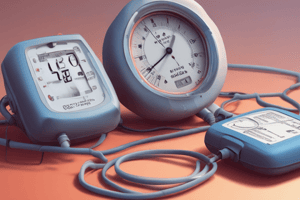Podcast
Questions and Answers
What is the primary goal of oxygen therapy?
What is the primary goal of oxygen therapy?
- To increase blood oxygen saturation (correct)
- To lower carbon dioxide levels
- To decrease blood oxygen saturation
- To induce sleep in patients
A normal SpO2 range, as measured by pulse oximetry, is typically:
A normal SpO2 range, as measured by pulse oximetry, is typically:
- 80% to 85%
- 85% to 90%
- 90% to 95%
- 95% to 100% (correct)
Which of the following is a common symptom of oxygen toxicity?
Which of the following is a common symptom of oxygen toxicity?
- Cough (correct)
- Decreased heart rate
- Increased energy
- Improved vision
A nasal cannula typically delivers oxygen at what flow rate range?
A nasal cannula typically delivers oxygen at what flow rate range?
What condition is characterized by low levels of oxygen in the blood?
What condition is characterized by low levels of oxygen in the blood?
Which device delivers the highest concentration of oxygen?
Which device delivers the highest concentration of oxygen?
What is the purpose of the reservoir bag on a non-rebreather mask?
What is the purpose of the reservoir bag on a non-rebreather mask?
What is the term for bluish discoloration of the skin due to poor circulation or inadequate oxygenation?
What is the term for bluish discoloration of the skin due to poor circulation or inadequate oxygenation?
Which of the following is a potential complication of oxygen therapy caused by high oxygen concentrations washing nitrogen out of the alveoli?
Which of the following is a potential complication of oxygen therapy caused by high oxygen concentrations washing nitrogen out of the alveoli?
Which device is best for delivering precise oxygen concentrations for COPD patients?
Which device is best for delivering precise oxygen concentrations for COPD patients?
What is the typical target SpO2 range for COPD patients receiving oxygen therapy?
What is the typical target SpO2 range for COPD patients receiving oxygen therapy?
Which of the following is an invasive method for measuring blood oxygen and carbon dioxide levels?
Which of the following is an invasive method for measuring blood oxygen and carbon dioxide levels?
What is a common method to prevent mucous membrane drying during oxygen therapy?
What is a common method to prevent mucous membrane drying during oxygen therapy?
Which of the following is a critical safety precaution during oxygen therapy?
Which of the following is a critical safety precaution during oxygen therapy?
What does FiO2 represent in the context of oxygen therapy?
What does FiO2 represent in the context of oxygen therapy?
Flashcards
Oxygen Therapy
Oxygen Therapy
Treatment providing supplemental oxygen for breathing-related conditions.
Hypoxemia
Hypoxemia
Low blood oxygen levels, a key reason for needing oxygen therapy.
Cyanosis
Cyanosis
Bluish discoloration of skin due to poor circulation or low oxygen.
Nasal Cannula
Nasal Cannula
Signup and view all the flashcards
Simple Face Mask
Simple Face Mask
Signup and view all the flashcards
Non-Rebreather Mask
Non-Rebreather Mask
Signup and view all the flashcards
Venturi Mask
Venturi Mask
Signup and view all the flashcards
Pulse Oximetry
Pulse Oximetry
Signup and view all the flashcards
Arterial Blood Gas (ABG)
Arterial Blood Gas (ABG)
Signup and view all the flashcards
Oxygen Toxicity
Oxygen Toxicity
Signup and view all the flashcards
Absorption Atelectasis
Absorption Atelectasis
Signup and view all the flashcards
COPD Target SpO2
COPD Target SpO2
Signup and view all the flashcards
HFNC
HFNC
Signup and view all the flashcards
Mechanical Ventilator
Mechanical Ventilator
Signup and view all the flashcards
Weaning from Oxygen
Weaning from Oxygen
Signup and view all the flashcards
Study Notes
- Oxygen therapy delivers oxygen to individuals with breathing-related conditions
Oxygen Therapy Basics
- The goal of oxygen therapy is to increase blood oxygen saturation
- Oxygen saturation is typically maintained above 90%
- Oxygen therapy can be administered in hospitals, clinics, and at home
- Oxygen delivery devices include nasal cannulas, masks, and ventilators
- Patient response monitoring is crucial for adjusting flow rate and delivery method
Indications for Oxygen Therapy
- Hypoxemia indicates low levels of oxygen in the blood
- Respiratory distress indicates difficulty breathing or shortness of breath
- Cyanosis indicates bluish discoloration of the skin resulting from poor circulation or inadequate blood oxygenation
- Pneumonia is a lung infection causing inflammation and fluid buildup in the air sacs
- Asthma is a chronic respiratory disease causing inflammation and narrowing of airways
- Chronic obstructive pulmonary disease (COPD) is a progressive lung disease obstructing airflow from the lungs
- Heart failure is a condition where the heart cannot pump enough blood to meet the body’s needs
- Carbon monoxide poisoning is a dangerous condition caused by inhaling carbon monoxide gas
Oxygen Delivery Devices
- Nasal Cannula:
- Delivers low-flow oxygen at 1 to 6 liters per minute (LPM)
- Oxygen concentration (FiO2) is between 24% and 44%
- Simple Face Mask:
- Delivers medium-flow oxygen at 5 to 10 LPM
- FiO2 is between 35% and 55%
- Non-Rebreather Mask:
- Delivers high-flow oxygen at 10 to 15 LPM
- FiO2 is between 80% and 95%
- Includes a reservoir bag for oxygen storage
- Venturi Mask:
- Delivers precise oxygen concentrations using color-coded adapters to set the FiO2
- Flow rates depend on the adapter and are suitable for patients with COPD
- High-Flow Nasal Cannula (HFNC):
- Delivers heated and humidified oxygen at high flow rates, ranging from 15 to 60 LPM
- Provides an FiO2 of 21% to 100%
- Improves patient comfort and reduces the work of breathing
- Mechanical Ventilator:
- Delivers oxygen and supports breathing for patients who cannot breathe adequately on their own
- Used in critical care settings and requires intubation or tracheostomy
Monitoring Oxygen Therapy
- Pulse Oximetry:
- A non-invasive method to measure oxygen saturation using a sensor on the finger or earlobe
- Normal SpO2 range is typically 95% to 100%
- The target SpO2 range for patients with certain conditions like COPD may be lower
- Arterial Blood Gas (ABG) Analysis:
- An invasive method to measure blood oxygen levels, carbon dioxide levels, and pH through a blood sample taken from an artery
- Provides a more accurate assessment of oxygenation and ventilation
- Clinical Assessment:
- Monitoring includes the patient's respiratory rate, effort, and breath sounds
- Assessing the patient's level of consciousness and overall condition
- Observing for signs of respiratory distress
Potential Complications of Oxygen Therapy
- Oxygen Toxicity:
- Can occur with prolonged exposure to high concentrations of oxygen causing damage to the lungs and other organs
- Symptoms include cough, chest pain, and shortness of breath
- Absorption Atelectasis:
- Occurs with high concentrations of oxygen cause nitrogen to be washed out of the alveoli which leads to alveolar collapse
- Mucous Membrane Drying:
- Oxygen can dry out the mucous membranes in the nose and mouth, so humidification is often used to prevent this
- Fire Hazard:
- Oxygen is a combustible gas, so precautions should be taken to prevent fires, especially around open flames and electrical equipment
Oxygen Therapy in Specific Conditions
- COPD:
- Target SpO2 range is typically 88% to 92%
- Venturi masks are often used to deliver precise oxygen concentrations
- High-flow oxygen should be avoided to prevent carbon dioxide retention
- Asthma:
- Oxygen therapy is used to treat hypoxemia during asthma exacerbations
- The goal is to maintain SpO2 above 90%
- Beta-agonists and corticosteroids are also used to treat asthma
- Pneumonia:
- Oxygen therapy is used to treat hypoxemia caused by pneumonia
- The goal is to maintain SpO2 above 90%
- Antibiotics are used to treat bacterial pneumonia
- Heart Failure:
- Oxygen therapy is used to improve oxygenation and reduce the work of breathing
- The goal is to maintain SpO2 above 90%
- Diuretics and other medications are used to manage heart failure
Special Considerations
- Pediatric Patients: children require careful monitoring and adjustments based on age and size during oxygen therapy
- Geriatric Patients: elderly individuals may have decreased respiratory function, so careful assessment and monitoring during oxygen therapy is important
- Home Oxygen Therapy: education on equipment use, safety precautions, and when to seek medical attention is needed for patients receiving oxygen therapy at home
Weaning from Oxygen Therapy
- This involves the gradual reduction of oxygen flow rate or FiO2
- Monitoring the patient's SpO2 and respiratory status
- Assessing the patient's ability to maintain adequate oxygenation without supplemental oxygen
- Discontinuation of oxygen therapy occurs when the patient can maintain SpO2 above the target range
Studying That Suits You
Use AI to generate personalized quizzes and flashcards to suit your learning preferences.





